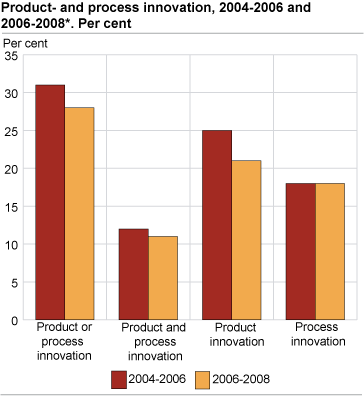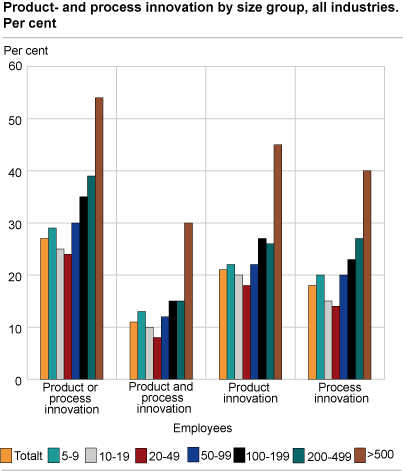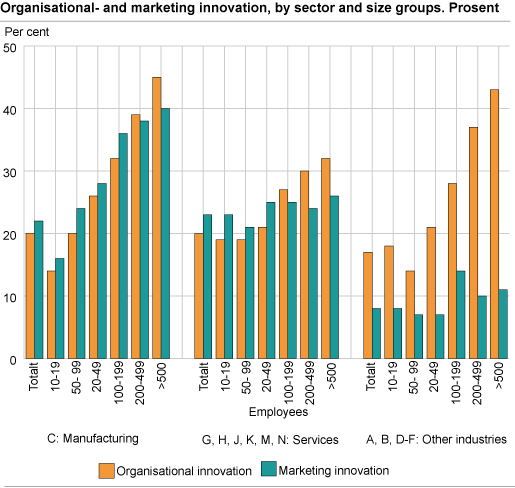Content
Published:
This is an archived release.
No increase in innovation activity
Results from the Norwegian innovation survey show that more than a quarter of Norwegian enterprises introduced innovations in products or processes during the period from 2006 to 2008. As in the previous survey, the level of innovation in Norwegian enterprises varies significantly between the various size groups and industries.
Among the enterprises covered by the survey, a total of 27 per cent introduced new or significantly changed products or processes during the preceding three year period. Twenty-one per cent brought new product innovations, while 18 per cent established new processes. Eleven per cent of the enterprises had both types of innovation. In addition, 7 per cent of the enterprises report having ongoing innovation activity or having abandoned such activity during the period under review without it having led to an innovation being introduced by the enterprise.
Long-term trend shows a decline
To facilitate a comparison between current and previous results, the data from the innovation survey covering 2004-2006 has been modified and re-aggregated in accordance with SIC2007. The samples for both editions were subsequently reduced to only include size groups and industries covered by both surveys. These results show that the 2008 survey represents a decline of 3 percentage points in the share of product or process innovators compared to the previous period. This is caused by a reduced likelihood that an enterprise will be a product innovator, while the share of process innovators has remained stable between surveys.
Due to the inherit nature of the survey, there is an inherit margin of error to its results, and the re-aggregation to SIC2007 increases this error somewhat. For this reason, the aforementioned reduction in the measured innovation is not in itself enough to conclude that the level of innovation activities has actually decreased. However, the survey for 2004-2006 also represented a minor decrease from the preceding period that was within the error margin at the time. When examined together, these results are sufficient to say that the long-term trend is somewhat negative.
Large enterprises still most likely to innovate
The likelihood that an enterprise will be innovative increases with enterprise size. This finding is consistent with, but somewhat less pronounced than, results from previous surveys. Only in the manufacturing industries is this tendency clear cut. As many as 73 per cent of the largest manufacturing enterprises were innovative, while in comparison the number is 25 for the smallest manufacturers.
Apart from the very largest size group standing out, the differences in innovation activity by size are lesser in the services sector and amongst the remaining enterprises1. Certain industries with a large share of small and medium-sized enterprises that are characterised by also having a very low share of innovators regardless of enterprise size are included in these categories. However, in the current survey, enterprises in these industries with less than 20 employees have been excluded from the sample. Thus, the results for the enterprise size groups above and below 20 employees are not directly comparable. Correcting for this discrepancy by also removing the said industries from the other size groups reveals an apparent increase in the innovation activity there of between 6 and 8 percentage points.
Nevertheless, it is still only from enterprises with at least 50 employees and over that the overall tendency is clear that the share of innovators goes up as enterprises get bigger. One interpretation of these results is that the previously observed strong relationship between enterprise size and innovation is driven to some degree by the fact that as enterprises get smaller, a large and growing share of the business enterprise sector as a whole belongs to a set of low-innovation industries.
The general observation that innovation propensity varies by enterprise size can have several explanations. For instance, larger enterprises will generally have more resources available to them, both in terms of finances and human capital. Additionally, large enterprises are also more likely to produce a wider scope of products and services encompassing a larger number of internal processes in the company. Thus, larger companies naturally have a larger chance that at least one of these areas will be significantly changed within the span of a three year period.
Mixed results for organisational and marketing innovation
The survey shows that both for organisational change and marketing, the share of enterprises with such innovations was 20 per cent. As with product and process innovations, the distribution of the innovators varies considerably between industries and size groups. There are more market innovators than organisational innovators in both the manufacturing industries and in services, but the differences between the two types of innovation are not major. Conversely, organisational innovations are clearly the most common in the remaining industries. Organisational innovations occur more frequently the larger the enterprises get within all industries, but the same trend is only present for the manufacturing enterprises when considering marketing innovations. These differences can largely be explained by that fact that bigger and more complex organisations have a natural need for organisational adjustments to a larger degree than smaller ones. Large manufacturing enterprises also produce a bigger range of physical merchandise where product turnover may facilitate the need for marketing change. Furthermore, earlier surveys have shown that organisational innovation and marketing innovation is often directly linked to product or process innovation in the enterprises, and as many as 56 per cent of the market or organisational innovators were also innovative with regard to products or processes.
About the dataThe Norwegian survey on the innovation activity in the business enterprise sector is undertaken by Statistics Norway in the form of a representative sample survey with the addition of complete coverage of enterprises with more than 100 employees. The survey is part of the Eurostat Community Innovation Survey (CIS), and consists of a census of the entire manufacturing sector and parts of the services sector. It also covers extraction of oil and gas, fish hatcheries and fish farms. The data discussed in this release belong to the sixth CIS survey (CIS 2008). New industrial classificationStarting with the annual statistics covering the year 2008, Statistics Norway has changed over to a new revision of the Standard Industrial Classification (SIC2007) based on the EU standard NACE Rev.2. Its primary objective is to provide rules and guidelines for industrial classification and unique definitions of the statistical units used in order to facilitate comparison and analysis of statistical information. Previous innovation surveys are published using SIC2002, and the results are not directly comparable with the current survey. Provisional data for CIS 2006 aggregated according to SIC2007 is available upon request. |
1These include the enterprise groups B: Mining and quarrying, D: Electricity and gas supply, E: Water supply, sewerage, waste, F: Construction, and 03 Fishing and aquaculture.
Tables:
Contact
-
Lars Wilhelmsen
E-mail: lars.wilhelmsen@ssb.no
tel.: (+47) 40 90 24 35



